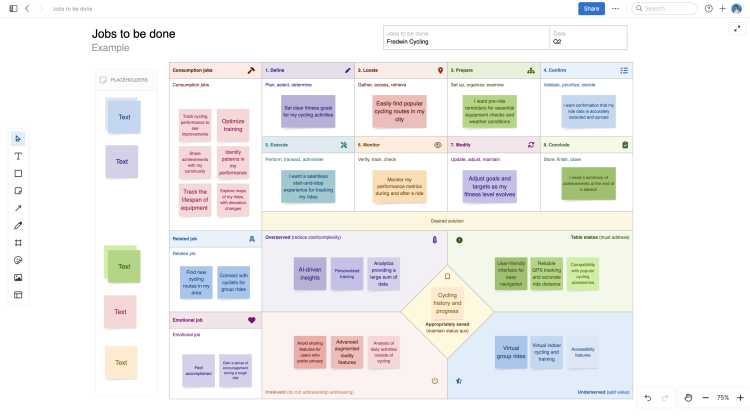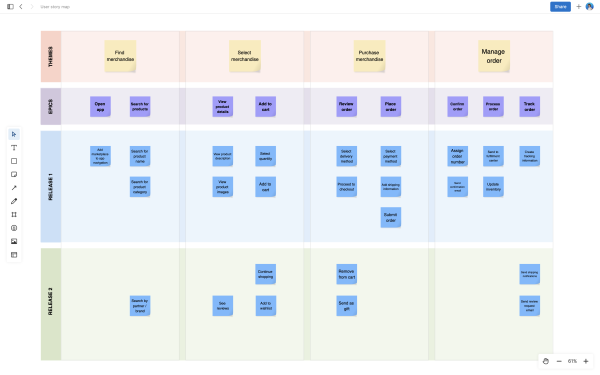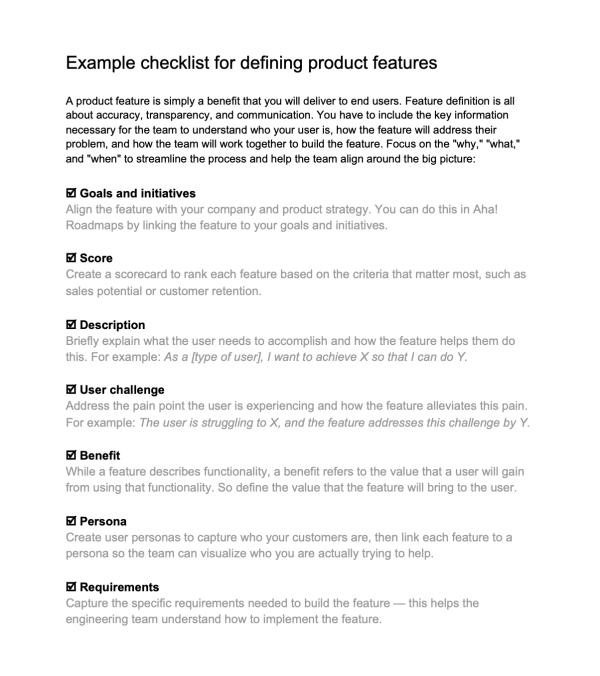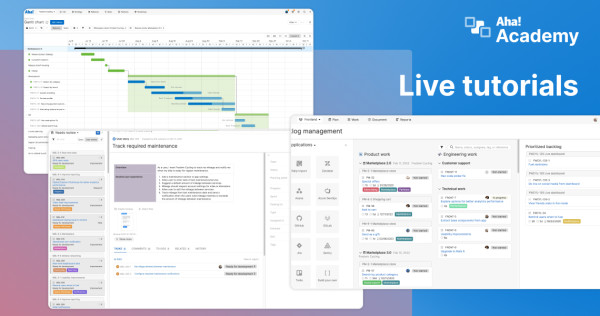What is the jobs-to-be-done framework?
Last updated: October 2024
The jobs-to-be-done (JTBD) framework is a prioritization tool that helps product managers better understand and empathize with customers. The emphasis is on delivering meaningful product experiences based on specific jobs customers need to complete. (You can think of a job as any action a user wants to take.)
Using a framework like JTBD can help you make more informed decisions about what to build next. The JTBD framework gives product teams a methodical way to think through the underlying reasons why people choose (or do not choose) a product or service. The ultimate goal is to improve the user experience and deliver greater value to customers.
In this guide, we will walk through the fundamentals of the JTBD framework. Explore how it works in practice — then use our JTBD framework template to try it on your own. This template is available for whiteboards in Aha! software.
Try the JTBD template in Aha! software.

Keep reading or jump ahead here:
Principles of the jobs-to-be-done framework
JTBD practitioners have written lots of in-depth content on the theory and principles underlying the framework. For the purposes of this guide, we will take a high-level view of the most important concepts so you can decide whether you want to apply any of them to your product development work.
As a product manager, you have a variety of methodologies you can use to home in on what customers need and how you can help them achieve their goals. What makes JTBD unique (compared to similar business model exercises or product prioritization frameworks) is its emphasis on delivering customer-centric outcomes.
According to the JTBD framework, the way to accomplish this is to internalize your customers' motivations — the results they are trying to attain, how they want to feel while using your product, and how they measure success when completing a job.
This translates to the nine core tenets behind the JTBD theory:
People buy products and services to get a “job” done.
Jobs are functional, with emotional and social components.
A job-to-be-done is stable over time.
A job-to-be-done is solution-agnostic.
Success comes from making the "job," rather than the product or the customer, the unit of analysis.
A deep understanding of the customer's "job" makes marketing more effective and innovation far more predictable.
People want products and services that will help them get a job done better and/or more cheaply.
People seek out products and services that enable them to get the entire job done on a single platform.
Innovation becomes predictable when "needs" are defined as the metrics customers use to measure success when getting the job done.
There are some overlaps between the JTBD framework and other approaches to product building and prioritization, such as contextual design, design thinking, user personas, and journey maps. Some critics complain that JTBD is really no different from what product builders have been doing since the early days of computer science: seeking to understand how users interact with technology to achieve their goals. However, the framework's supporters contend its benefits lie in its clear principles and processes.
What is a job-to-be-done statement?
The JTBD framework is complex — it encompasses several theories and concepts. But the simplest way to begin capturing exactly what customers want to do is by writing a job-to-be-done statement. This is a short, precise sentence that explains the job and desired outcome from the customer's perspective. This statement can convey what customers want to accomplish or a problem they need to solve.
Here is the basic format of a job-to-be-done statement:
[Verb] + [Object] + [Context]
In the case of a fitness app, for example, you might fill in the blanks to say, "improve physical health to live longer " or "increase strength to boost endurance." This conveys that users want a product to help them complete these jobs and achieve the outcome of better fitness. Defining jobs like these is the basis for using the JTBD framework.
JTBD framework components: Job types, steps, and outcomes
You will define numerous jobs when working with the JTBD framework. (Customers rarely use products to do just one thing.) The framework will help you categorize and map out different jobs so you can dig into what customers need to accomplish from several areas.
According to JTBD theory, there are six types of jobs that you should consider to get a full perspective of what customers truly need. Here is an overview of those job types using our earlier example of a fitness app:
Job type | Example |
Core functional job-to-be-done | What the customer is trying to do (for example, tracking daily workouts in a mobile app) |
Desired outcomes tied to the core functional job-to-be-done | The result the customer wants to accomplish as a consequence of doing the job (such as improving fitness or lowering body fat percentage) |
Related jobs | Secondary or tertiary objectives the customer is trying to achieve (for instance, monitoring exercise frequency or connecting with fitness-minded friends) |
Emotional and social jobs | How the customer wants to feel when completing the core functional job (such as competent, accomplished, or calm) |
Consumption chain jobs | How the customer learns to use the product and interacts with customer-facing groups such as support (for example, asking a question or seeking help for a problem that occurs when using the app) |
Buyer's financial desired outcomes | What the buyer considers before making a purchase, including financial goals or metrics that must be met (remember that the person deciding whether to make the purchase might not be the actual user) |
In addition to these job types, there are also eight steps that jobs move through — from definition to completion. When using the JTBD framework, you will map out customer needs at each step for your core functional job-to-be-done. This can help your product team pinpoint where friction or unmet expectations exist in your customer's journey to complete the job. Here is a brief overview of these steps:
Define: The customer identifies what they need to accomplish and why it matters.
Locate: The customer researches and gathers the necessary resources to perform the job.
Prepare: The customer sets up the environment to begin the job.
Confirm: Before starting the job, the customer ensures everything is ready to go.
Execute: The customer begins performing the job, putting plans into action to achieve the desired outcome.
Monitor: The customer checks progress to ensure that the job is going as planned.
Modify: If obstacles arise, the customer adjusts their approach.
Conclude: The customer completes the job and assesses the outcome.
Once you have mapped out jobs across these eight steps, you will examine the outcomes. Your team should consider how customers feel about using your product to complete jobs and how well the outcomes meet their initial needs.
The JTBD framework outlines five types of outcomes, each of which presents unique opportunities to take action with your product:
Job outcome | Description | Product opportunity |
Appropriately served | Needs are well met. | Continue with the status quo for this job. |
Overserved | Needs are met in excess, beyond what customers care about. | Simplify offering in this area to reduce cost or complexity. |
Table stakes | Needs can be satisfied with alternate solutions that are available. | Ensure these basic-level needs are met first in order to compete in the market, then consider how to differentiate your offering. |
Irrelevant | Needs no longer matter. | Stop addressing and divert resources to what matters most. |
Underserved | Needs are not fully met. | Consider new features or enhancements to add more value. |
The JTBD framework can be complex to grasp. But understanding how to define different types of jobs, steps, and outcomes is a good place to start. This exercise will help you grasp the fundamental benefits of the framework (do not forget to use a template for an extra boost and check out the complete JTBD example below).
Why use the jobs-to-be-done framework (and why not)?
There are at least a dozen common product prioritization frameworks — so why should you choose JTBD? Many product teams struggle to build customer empathy. It can be tempting to forge ahead on the ideas you are most excited about without pausing to fully consider whether your customers will be excited about them, too. If you are struggling to connect with your users in this way, then the JTBD framework is a good one to try. It encourages you to slow down and dig into customers' needs first.
But some folks choose not to use JTBD because it can be a high-level, abstract, and time-consuming endeavor. A lot of customer research is necessary to fully complete the framework, and it can be challenging to translate customer "jobs" into concrete functionality. It also does not account for other prioritization factors that matter — such as the effort required to build new features. (The RICE framework or a product value score are two examples that provide a more well-rounded view.)
Like any approach, the JTBD framework has its pros and cons. Remember that you might want to borrow elements from multiple frameworks as you move through product development, or even create your own. It depends on you and what works best for your product team.
Related:
How to use the jobs-to-be-done framework
The JTBD framework is most helpful during the planning stage of the product development process. This is when you refine ideas and prioritize which product features the team will build. In this context, JTBD entails collaborating with the product team (including developers and UX designers) on which new features will resonate with customers, plus how to improve existing ones. The goal is to understand who is using your product so you can create the best-possible user experience.
JTBD is also useful during the strategizing and ideating phases of product development — when you are defining goals and capturing promising ideas. This tends to be a more theoretical exercise, as you seek to understand who your potential buyers are and what type of offering they would benefit from. Instead of prioritizing features for a product that already exists, a business or product leader would think strategically about how to develop a new product or enter an underserved market.
Related:
Jobs-to-be-done framework example
Let's get hands-on. Below is a filled-in example of the JTBD framework using the same JTBD template we shared earlier in this guide. (If you try the template, it comes with this example data on the whiteboard so you can get a closer look.)
The example features the same type of product we used earlier: a fitness app. Zoom in to see how the product team might examine jobs to be done for its customers — including different types of jobs, how those jobs progress through the eight steps, and various opportunities uncovered in this process.

Whether or not you use JTBD, your ultimate aim is to come up with innovative solutions and deliver an experience that customers truly love. Cultivating greater customer empathy is key within the JTBD approach. After all, you are responsible for thoughtfully considering what your customers need and how they interact with your offering. When you deeply understand the people you are building for, you are better able to deliver a lovable product and Complete Product Experience. Consequently, customers tend to be happier and more likely to support the business over the long run.
FAQs about the jobs-to-be-done framework
What is the history of the JTBD framework?
JTBD grew out of outcome-driven innovation, a strategic innovation process invented by Tony Ulwick in the late 1990s. As the founder and CEO of an innovation consulting company, Ulwick realized that his most successful clients adopted a customer-centric approach to product development. In other words, they focused on giving customers the specific outcomes they were seeking rather than the product features they might have wanted (or said they wanted).
Ulwick formalized his ideas into the JTBD framework and began writing articles and books on the topic. The thrust of his argument is that businesses should think about the value they create according to what customers want to achieve with a product. By focusing on what a customer's desired outcome is, product teams can build a product that helps people reach that goal. In turn, companies can spot more opportunities for innovation and deliver greater value for customers and the business.
What is the difference between a job-to-be-done statement and a user story?
If you are familiar with user story mapping, you have probably noticed the similarities between job-to-be-done statements and user stories. The fundamental difference is that job-to-be-done statements are more holistic and abstract — they represent what a user wants to do in the future. User stories, on the other hand, describe how a user would actually use a specific product or technology to complete a task.
What is the difference between the jobs-to-be-done framework and The Aha! Framework?
The JTBD framework and The Aha! Framework are both approaches that product teams can use to be more customer-centric. Both are designed to help you identify what will deliver the most value.
Scope is the primary difference. JTBD is a prioritization framework that focuses on learning why customers use a product by defining the "jobs" they need to get done. You examine customer motivations and unmet needs to inform what you will build. That makes it well suited to feature exploration and product planning, but it does not cover how to manage the entire product lifecycle.
In contrast, The Aha! Framework is a methodology spanning the entirety of product development — from strategy and roadmapping to delivery, with an emphasis on cross-functional alignment. It includes guidance on key activities to perform to ensure everyone is working toward shared goals and delivering on a clear product vision.


